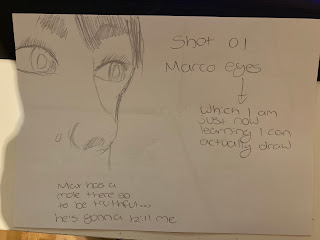The Arrival
Short Film Research – The Arrival (2016)
This
films centres on Anna, a young woman sat in a small public café awaiting the
father of her yet-to-be-born child. The narrative is told through a voiceover
of Anna’s internal monologue as she debates a potential abortion. The serious
subject matter of this film is represented through a heavily desaturated, nigh
muted, colour palette, with the café being displayed in deep reds and browns
while Anna’s jumper is the brightest focal point in cream. Aside from that,
Anna is presented as simply ordinary, her costume and make-up reflecting just a
typical person, displaying a deeper truth that the film wishes to communicate –
that many women have been in a similar place to her.
The
films is also, and notably, shot in a single long take. The camera starts behind
a door, obfuscating Anna in the café before the door opens and the camera begins
to eek closer and closer to her as it dollys through the harshly lit
environment. The mise-en-scene of the space also functions symbolically, with the
clock mounted on the wall behind her becoming a manifestation of the ‘ticking
clock’ of her biology, likewise the window functioning as the father’s “big
biological window”. An elderly couple also pass by, affectionately holding
hands, before Anna loses focus and spills her coffee upon seeing a baby. These
extras also act as metaphors for Anna’s experiences, with the couple potentially
representing her and the father, and the baby their own child.
At
this point the film becomes significantly less naturalistic and veers more into
expressionism, as the café location that we have become familiarised with morphs
into a train carriage. This could be taken as a metaphor for her journey
through life or as a literal symbol of her decision to run away alone, but the
film leaves this deliberately ambiguous.
That
said, the film ends with Anna being isolated as the camera pulls away from her
as she asks the waiter for a “decaf instead”, hinting that she has decided at
the culmination of her internal debate to keep the baby and as such refuses caffeine.
Though this could also just be personal preference. Again, the film leaves this
ambiguous.
Given
that I do not particularly wish for my film to delve to far into serious
subject matters, instead leaning more towards comedy, I don’t reckon there’s
much to take from this film narratively. While I enjoy the open-ended subtlety present
here, I’m not sure how I would weaponize it in my own film. Notwithstanding, I
have always enjoyed the use of long takes in films and television, so I
certainly aim to use a couple in my own project if appropriate. Maybe not to
the same degree as here, but 15-30 seconds seems more reasonable. We’ll have to
see.



Comments
Post a Comment